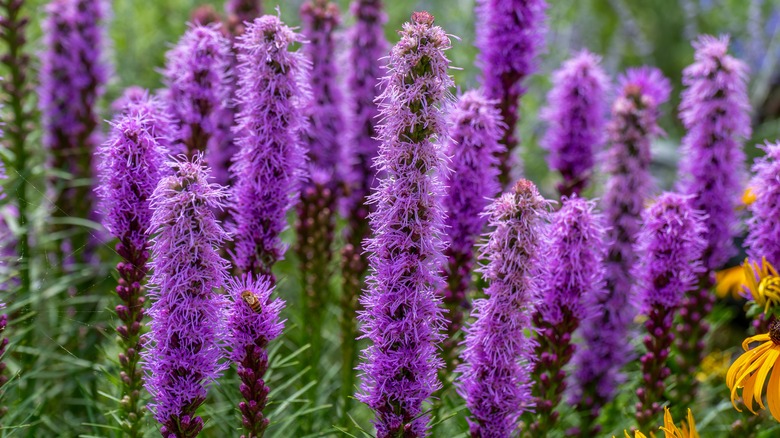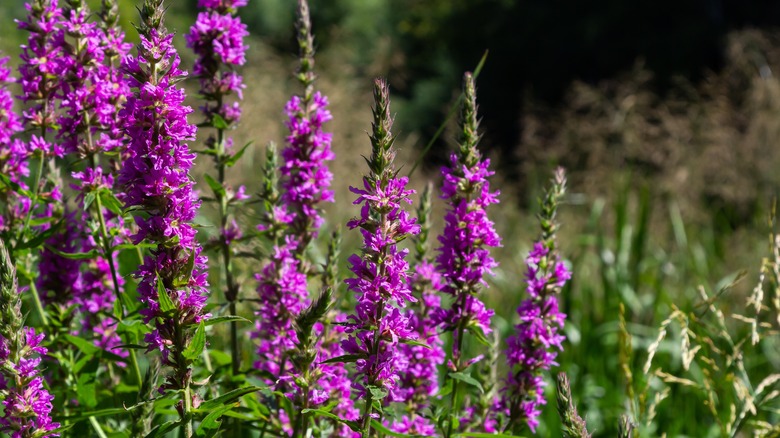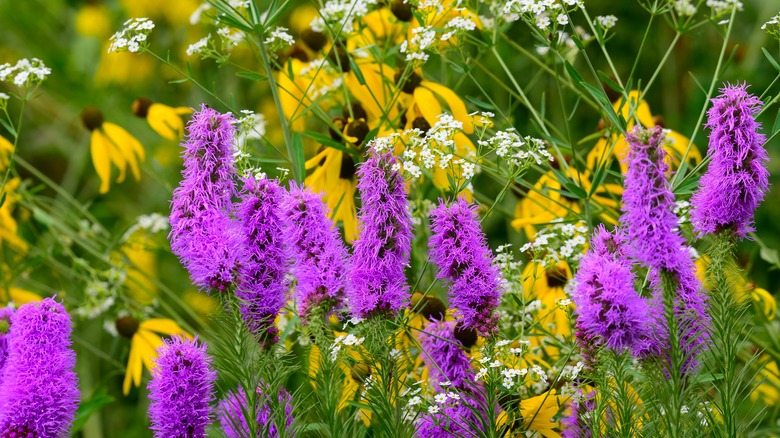Don't Mistake Beautiful Blazing Star Flower For Its Weedy Look-Alike
It's easy to confuse certain flowers in the garden, especially when they look strikingly similar. On a surface level, mixing up your plants can seem like no big deal, but misidentifying them can be detrimental to their health when their individual care requirements aren't met. The blazing star (Liatris spicata) is one such plant that often gets mistaken for purple loosestrife (Lythrum salicaria). Though they share an almost identical appearance, blazing star stands apart from its weedy doppelganger with its spiky flower heads, blooming pattern, and leaf size. Unlike purple loosestrife, which you should avoid growing because it's actually a noxious weed, blazing star is a welcome addition to any garden.
Belonging to the aster family, this fuzzy looking plant can be grown from seed, corms, and transplants. You can grow blazing star successfully by paying attention to its planting location and soil and water requirements. With its royal colored, bristling blooms, blazing star is not only beautiful, but a magnet for pollinators. It may just become your next garden favorite.
What's the difference between blazing star and purple loosestrife?
Blazing star and its look-a-like purple loosestrife, share many similarities, but key differences can help you tell them apart. You'll notice that purple loosestrife has a square, woody stem, while blazing star has a rounded one. Purple loosestrife has 1- to 4-inch long, fuzzy leaves that grow in whorls or spirals along the stem. Blazing star, on the other hand, has smooth to slightly hairy leaves that can be as large as 12 inches long, though they get smaller towards the top of the stalk.
When it comes to blooms, the wrinkly petals of purple loosestrife vary from shades of magenta to purple. Similarly, blazing star produces purple flowers, but their petals are shaped like spikes. This is due to the disc florets that give the flower petals their characteristic bottlebrush appearance. Lastly, purple loosestrife blooms from the bottom of the stem to the top. Contrastingly, blazing star flowers blossom from the top of the stalk, eventually making their way to fill out to the bottom. Although keeping these characteristics in mind is helpful, it wouldn't hurt to have some plant-identifying apps on your phone to confirm whether you're dealing with the weedy, purple loosestrife or the feathery, blazing star just in case you forget.
How to grow blazing star
Blazing star can be grown in USDA hardiness zones 3 to 8 from seeds, corms, or transplants. Before planting, test your soil's pH, since blazing star prefers slightly acidic soil. Choose a sunny or partially shady spot with well-draining soil for your planting site. You can start seeds indoors or sow directly into the soil in spring, after the last frost. When planting, push seeds ¼ inch into the soil and lightly cover them. If you're growing blazing star from corms, dig a 2- to 3-inch hole in your soil and place them inside with the roots facing down. Bury them with soil and remove any air pockets. Water seeds and corms after planting and whenever the soil dries as they germinate. Seeds should sprout in 20 to 45 days, but they won't flower until one to two summers later.
On the other hand, blazing star transplants will flower in their first year. Grow transplants in a similar location as seeds and corms, but plant them 12 to 15 inches apart. Adequate spacing ensures good air circulation to prevent fungal diseases. Regular watering is essential to establish a strong root system, but don't overwater as this can lead to rot. Most blazing star varieties bloom in the summer, but that can vary. When in bloom, they attract pollinators. In fact, there are many varieties of blazing star that hummingbirds will love. Care for this plant well and you will reap the rewards.


